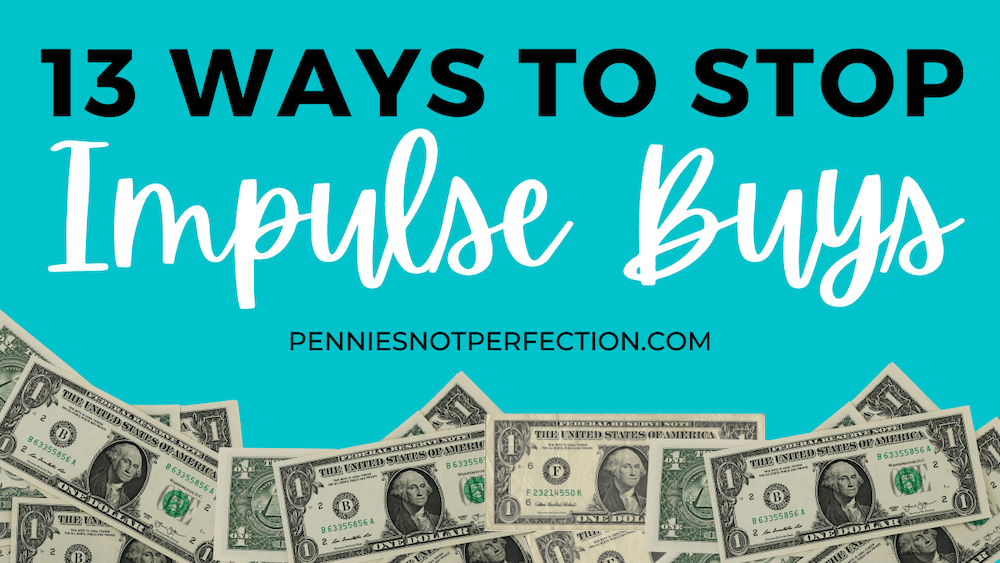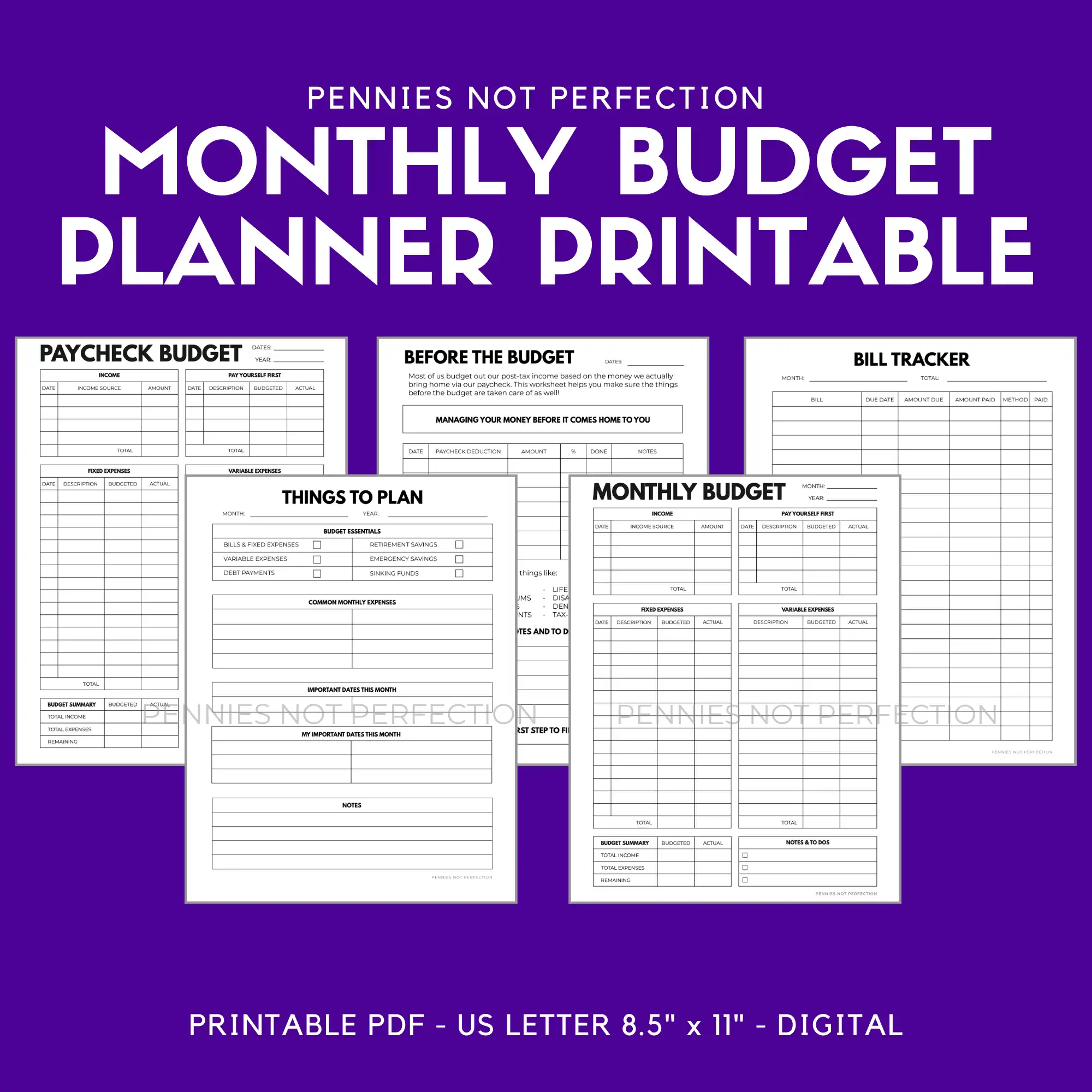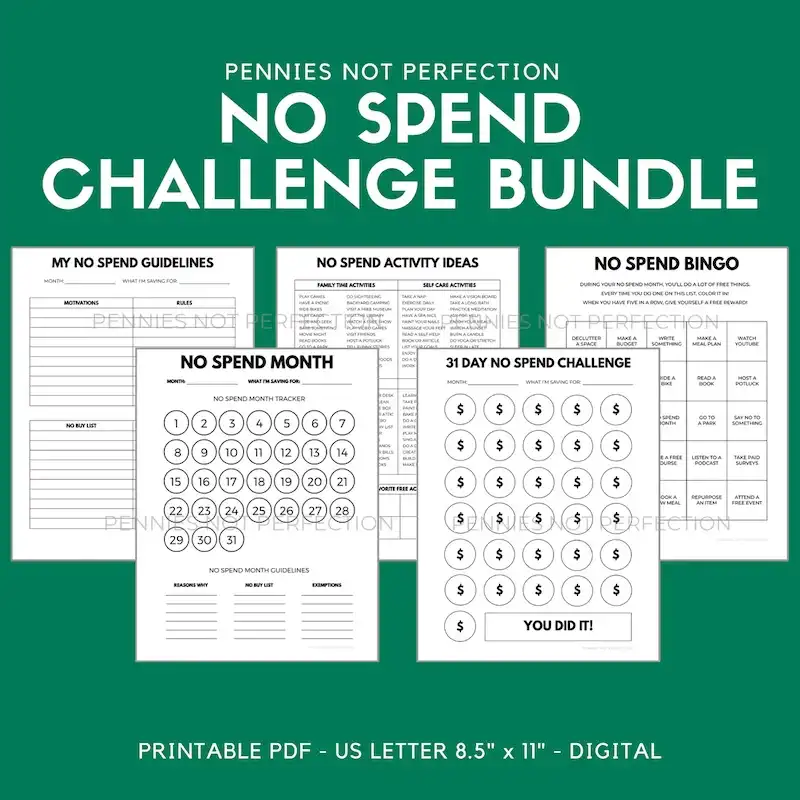Impulse buying is fun until the bill arrives. For many of us, myself included, impulse buying gives our brains a much desired bump in feel good chemicals. But it derails financial goals which is why many of us have to learn how to stop impulse buying.
Impulse buying is a very, very normal habit.
Almost all of us do it. And many studies show Americans on average impulse buy $250-$350 worth of items every single month.
You don’t want to think about those numbers adding up.

What Is An Impulse Buy?
So what exactly does impulse buying even mean?
An impulse buy is every time you purchase something you weren’t planning to.
It’s every time you are shopping and see something that you then buy. It’s when you add to cart something that wasn’t even on your radar.
Impulse buys can vary in size. A small candy purchase at the grocery store checkout line is an impulse buy if it wasn’t planned. So is an $80,000 SUV that you weren’t planning to sign up for when you went to browse the dealership.
There are many different but common impulse purchases:
- candy / gum / drinks in a checkout line
- treat yourself buys that were not planned
- shoes or clothes you weren’t planning to buy
- takeout or coffee from a shop
- toys or snacks to keep kids busy at the store
Many of these are common purchases. The issue is that they are impulsive in-the-moment decisions instead of planned.
What Drives Impulse Buying?
Since discovering my own tendency to impulse buy items I’ve tried to learn more about what causes impulse purchases.
There are many different reasons people make purchases. There are also lots of different triggers for impulse spending.
Here are a few common reasons people impulse buy:
- emotions & emotional driven needs
- past experiences
- lack of self-control / executive function
- ADHD (Attention deficit hyperactivity disorder)
- sales and marketing from stores
- love of shopping and making a purchase
These are reasons why some people impulse buy. These things can create the impulse and the desire to follow through on the purchase.
So how do we combat these things?
Is it even possible to cut back on impulse spending? Can we learn how to stop impulse buying?
How To Stop Impulse Buying
Unfortunately buying things feels good and stores are designed to get us to buy things. That means we have to create processes and habits to combat these factors.
Here are a few ways to stop the impulse spending habit:
1. Create A Wants List
I have a list of all the things I really want to buy. If it’s not a need, it goes onto the wants list.
Nothing that is a “want” can be purchased immediately, but instead it must go onto a want list. This helps me prevent immediate impulse buys.
When I decide it is time to splurge because I’ve accomplished a financial goal, I consult the wants list and purchase something off the list!
It’s guilt free spending because it is something I’ve wanted and thought about instead of impulsively buying on a whim.
Often I’ve found myself removing things from the list after 30 days or so. This is especially true of things I’ve found while browsing Amazon. In the moment they seemed like a great idea but after reflection I usually decide I don’t actually like the item as much as I did when I first encountered it.
2. Budget & Track Your Spending
Budgeting your money and tracking spending helps reduce impulse spending.
Having a budget at the beginning of the month helps you know where your money needs to go. When your money is part of a plan then it’s less likely to be spent on impulse.
This monthly budget printable is a grouping of everything you need to plan and track your monthly budget. These monthly budget worksheets are designed to help you keep your budget on track by writing it down each month and tracking where your money goes.
Tracking your spending and your financial goals can help keep you on track.
If you have never tracked your spending before, then this process can be eye opening. Tracking what you spend can illuminate how much money was spent impulsively. You’ll notice spending on items that weren’t necessary – or you don’t even remember buying!
If you need help starting a budget, check out these related posts:
- What Is The Purpose Of A Budget?
- Budgeting Tips For Beginners
- How To Create Your First Budget
- Budget Categories List
3. Create A 24 Hour Rule
Creating a time rule around spending can greatly prevent impulse spending.
If you see something you want in a store, tell yourself you can come back and buy it in 24 hours if you still really want it. Or if you are shopping online, put the item in your cart and come back the next day to finish checking out.
If you completely forget about the item, which often happens to me, then you really don’t need it!
The 24 hour rule even works for things on sale since sales often last more than 1 day. If you are worried a store will run out of the item you can always have them hold it for 24 hours which gives you the chance to really think about buying it.
If an item you want is still desperately desired after 24 hours, go ahead and buy it if it’s within budget!
4. Think About Why You Really Want It
Self-medicating with shopping is really easy.
Examining why you are spending money is much harder. Looking at the reasons you spend may mean you don’t make the purchase.
This is something I personally didn’t like doing in the past because the answer wasn’t something I wanted to deal with in the moment. It was easier to skip thinking and go straight to purchasing.
Shopping is an emotional process and often we use it to deal with other emotions.
When you understand why you want to buy something you can decide if it’s worth buying… or if you are using the purchase to pacify another need.
Forcing yourself to think about why you want to buy something forces you to see if you really want the item of if you are trying to meet a completely different emotional need. Instead of shopping, you might need to work on a completely different activity.
5. Recognize Your Buying Triggers
If you are an impulse shopper, do you know why you do it?
What happens around you or in your mind right before you make an impulse buy?
If you look at your behavior for the past month you can probably see some patterns and recognize your buying triggers.
- Do you impulsively shop when you are sad? Angry? Bored?
- Do ads on Facebook lead you to click and purchase on Amazon?
- Are sale flyers triggering you to go buy things you weren’t planning?
- Does taking the kids to the store cause impulse purchases?
Learning what triggers your impulse shopping can help you avoid those situations in the future.
For example you can use an ad blocker on social media sites or look for healthy ways to deal with emotions instead of shopping. Understanding what triggers your shopping is key to helping you stop it.
6. Stay Out Of Stores
The more often you are in a store the more chances there are to spend impulsively.
Stores are not a place to waste time or use as a hobby. It’s best to skip using shopping as a hobby and instead find ways to stay out of stores.
Personally I’ve stopped going to stores during my lunch break when I had a habit of spending impulsively. Without surrounding myself with the temptations of things I might want to buy, I am spending much less.
If you find yourself spending too much money and time in stores, seek out new places you can enjoy that don’t involve retail.
7. Get Off Store Email Lists
Similar to the concept of staying out of stores, get off the email lists too!
Joining a store email list for a discount seems like a good idea. But then you’re caught in their email marketing where they are constantly sending you things to buy.
If you have poor impulse control this is a disaster waiting to happen.
Unsubscribe from email lists that want to sell you something. Sign up long enough to get the discount and then unsubscribe. You can always rejoin again later.
Removing this type of marketing from your inbox removes another trigger for impulse buys.
8. Use Cash Instead Of Credit Cards
Recently I decided to get gazelle intense about paying off debt so I stopped using credit cards.
Credit cards can be great when used carefully and paid off meticulously, but they can make impulse spending much easier.
Paying with cash forces you to confront your impulse spending.
When you are feeling the urge to spend unnecessarily, counting out the cash makes you slow down and think about the purchase. You also have to know you have the money to pay for the item before checking out.
Buying has much more importance and you realize the impact instantly instead of at the end of the month when the credit card bill arrives.
When I use cash I have drastically reduce my own impulsive spending.
9. Shop With A Plan
Having a plan can help you cut down on impulse buys.
If you walk into a store without a plan or a list it’s easy to go overboard with impulsive purchases. Everything will feel like a need if you don’t have your needs clearly outlined.
Before you go shop you should create a detailed list of what you plan to purchase. Nothing should be added to this list.
Having and sticking to a shopping plan can help you cut down on impulse buys especially at the grocery store.
10. Check Your Emotions First
Emotional spending is a huge issue for impulse buyers. Our emotions drive our behavior and this can lead to unwanted spending.
If you are feeling emotional – mad, sad, angry, lonely, etc. – then you should not go shopping. Do not go to a store when you are flooded by feelings.
Make a commitment to yourself to always check your emotions first before you shop and make a purchase.
Many times we can make impulse buys when we are feeling emotional that we later regret. Don’t buy anything if you are feeling like you are out of control emotionally. Instead reach for another coping habit or reach out to a friend.
11. Try A No Spend Challenge
No spend challenges can be a fantastic way to reset financially. They can also help you work on impulse purchase problems.
A no spend challenge is where you spend a certain amount of time, usually 30 days, spending nothing outside of the bare necessities.
This No Spend Month Challenge printable bundle will help make a no spend challenge month easier and more fun.
When you do a no spend challenge you are forced to look at your spending habits. You also have to examine the triggers and emotions that drive those habits.
After 30 days of a no spend challenge you are likely to be more in tune with why you were spending before. You’ll have a better chance of thinking through purchases first after a challenge.
12. Add Purchase Friction
Purchase friction means making it harder to actually make a purchase.
Stores have whole teams dedicated to removing friction so it’s easier for you to spend money. Amazon’s 1 click program is a great example of how easy they’ve made it to make impulse buys – you don’t even realize you are spending money!
Work on adding back purchase friction wherever you can. You want to make it harder to buy something so your brain is forced to think about the purchase you are making.
Do things like:
- removing stored credit cards on your phone and computer
- removing all payments on sites like Amazon
- only taking cash to stores and leaving cards at home
There are many ways to add friction to your purchases so you must think instead of being impulsive.
13. Remember Your Financial Goals
One way to stop impulse spending it to keep your financial goals in mind before you waste money in stores. Reminding yourself that small impulse purchases add up to a lot of money that can prevent you from achieving these goals.
Personally I like to keep my financial goals where I can see them, with a list of my financial goals for the year in my planner and on the wall at home where I can see them. The reminder is helpful to keep them fresh so I’m more likely to meet those goals instead of impulsively use the money for other frivolous items.

My Experience With Impulse Buying
One bad habit I’ve had for as long as I can remember is impulse shopping.
If I see something in the store on sale I will buy it, even if I don’t have an immediate use for it. I will sometimes think of something I want and add it to my Amazon cart and checkout in under 3 minutes.
The time from when I first think “I want that” to actually owning it is far, far to short. That has led to lots of overspending due to impulse buys.
These purchases are usually unrelated to what I actually need to buy and they often come with regret that sets in later when I see my credit card bill or check my bank account.
Stores make it incredibly easy to do this both in stores and online so I’ve been working on ways to combat this habit and keep more of my hard-earned money.
Unfortunately buying things feels good and stores are designed to get us to buy things. That means we have to create processes and habits to combat this.
My most successful habits that have reduced impulse spending are removing myself from email lists and always making a list.
These two things have really helped me cut out the majority of where my impulsive spending was happening.
Stop Impulse Spending For Good
These are just a few of the ways you can stop impulse buying.
I’m still in the process of breaking my own impulsive spending habits but I know that these methods work. I’ve already curbed a ton of my impulsive spending and am happily sticking to my budget!
Mary is the founder of Pennies Not Perfection where she shares her journey to build wealth through online income. She quit her day job in 2021 after she paid off her debt and doubled her 9-5 salary.
Mary's favorite free financial tool is Personal Capital. She uses their free tools to track net worth and work toward to financial freedom.
Her favorite investment platform is M1 Finance, where she built a custom portfolio for free with no fees. She shares her portfolio growth and savings progress every month on YouTube.


